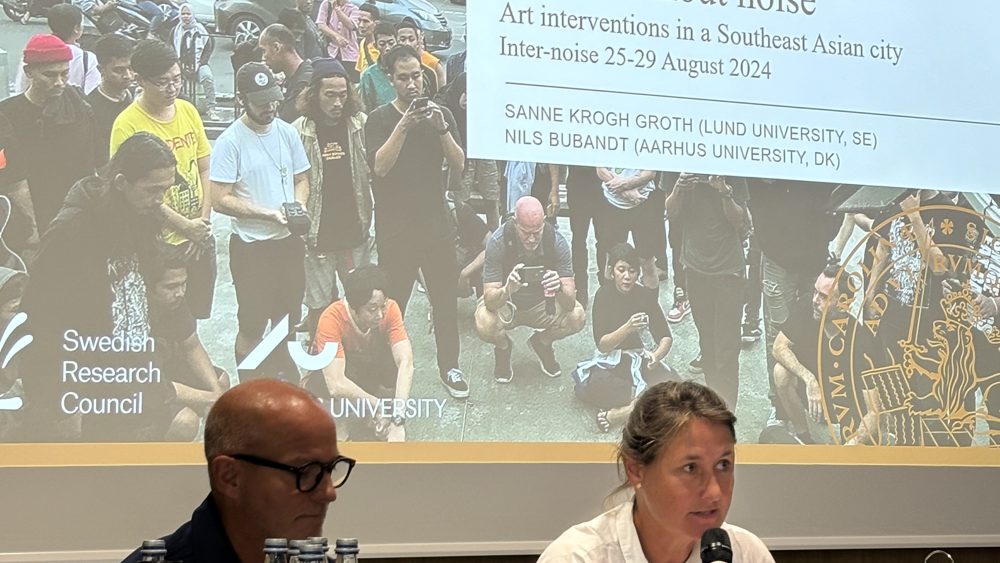“What is noise aesthetics in a place where everything is “noisy” and where this noisiness, furthermore, does not seem to be experienced as a problem or provocation? Can one even speak of “noise” if it is not unwanted? “
These were the questions raised in our presentation at the conference Inter-Noise 2024 in Nantes, France.
Here is the introduction from our full paper, which later will be published in the proceedings from the conference:
INTRODUCTION
The DIY music collective Jogja Noise Bombing in the Javanese city of Yogyakarta is known in international electronic music circles for its so-called “noise-bombings”, pop-up performances of harsh noise music played on DIY instruments in public spaces around the city. These performances have since early 2010 been performed in the noisy streets of Yogyakarta, both during the annual Jogja Noise Bombing festival and as impromptu occasional performances. Despite their international recognition within underground avantgarde music milieus, city ordinances regulating public order and soundscapes in Europe have meant that the Indonesian collective has not been able to organize similar “noise-bombings” in the Global North. European municipal misgivings about public pop-up performances of artistic noise contrast sharply with the ease with which organizers get to organize “noise-bombings” across cities in Java. European wariness about public noise bombings also contrasts with the way the Indonesian public reacts to them. Public performances of noise-bombings in Indonesia are either the object of mild curiosity or are studiously ignored by casual passers-by and figures of public authority alike in the performances we have attended. Rarely, if ever, do the performances provoke offense, objection, or attempts to shut them down. The noise-bombings, it seems, are not considered “noisy” at all. Why might that be?
This paper, in which we will try to answer this question, is a part of a larger research project called Java-Futurism: Chronotopes of Sound Activism in Indonesia, funded by the Swedish Research Council. The project studies trends in experimental music genres in Java such as electronic dance music and noise music through fieldwork, performance attendance, digital ethnography, and interviews with artists and producers. We gather these diverse methods within what we call an “aesthetic-anthropological” approach that combines the analytical aesthetic expertise of Sanne, who is a music historian and sound studies scholar, with the sensory and historical ethnography that Nils has developed as an anthropologist during fieldwork in Indonesia over thirty years.
With a point of departure in this cross-disciplinary approach to the aesthetics and anthropology of the situated sound – aesthetic and otherwise – of noise bombings in Yogyakarta, the paper raises a discussion about the ontologies of noise as such by asking: What is the aesthetic and political appeal of noise music in a context where noise – in its broadest sense – is rarely considered disruptive? We propose the need to “pluralize” the scientific understanding of noise along two axes: aesthetic-historical and political-historical. Indonesian noise music provides an instructive exemplar for this need to pluralize a universal notion of noise that informs both Western acoustic studies of noise and Western aesthetic studies of noise music. These two Western universalisms of noise and noise music were shaped by a common history. Noise music emerged from early twentieth century Euro-American aesthetic experiments and developed into a specific musical genre in the 1980s as a trend that highlighted the aesthetic qualities of noise and marked a rupture with common-sensical, acoustic perceptions of noise as “bad”, “unintentional”, “unwanted”, and even “unhealthy” [1]. This signaled in the context of EuroAmerican history an aesthetic pluralization of noise from being merely unwanted or bad into also being a potentially valorized aesthetic expression [2]. This pluralization disrupted the notion of noise with critical socio-aesthetic implications [3]. In this paper, we follow a second pluralization that dove-tails with the first: namely what happens when “noise music” emerges in Indonesia, where other socially embodied histories of hearing have sedimented into different ideas about what “noise” might be in the first place. In this context, we argue, neither noise nor noise music are what they are in Europe. The paper, in that sense, argues for a scientific pluralization of noise that is both aesthetically and anthropologically sensitive. It proposes an aesthetic-anthropological and comparative approach to capture the social, aesthetic, and historical plurality of noise.
Did you find it interesting and do you want to know more? Click here to read the full paper.

